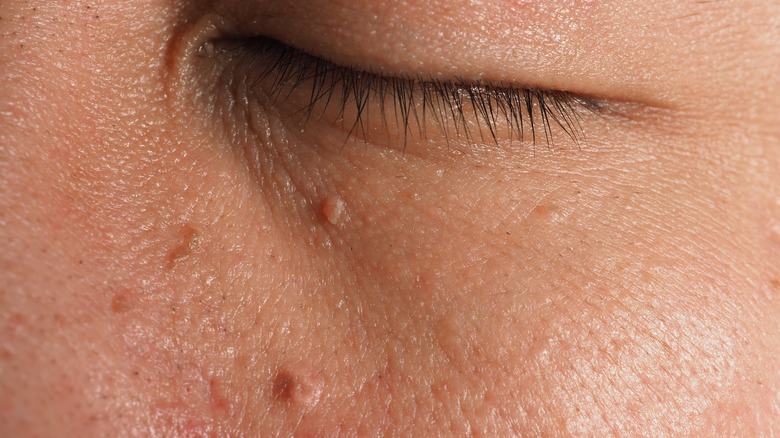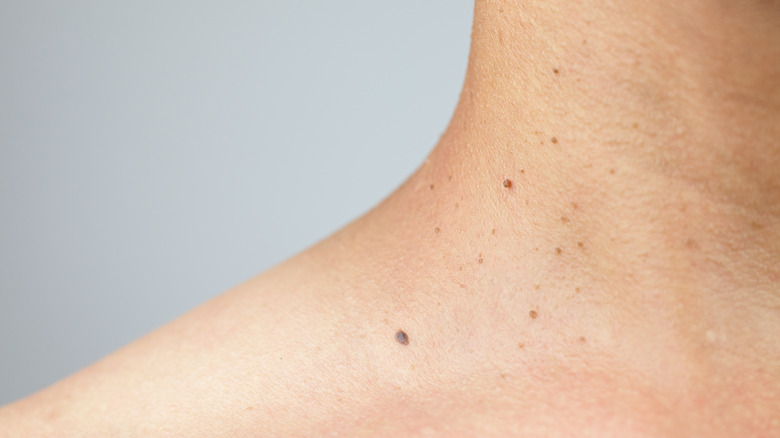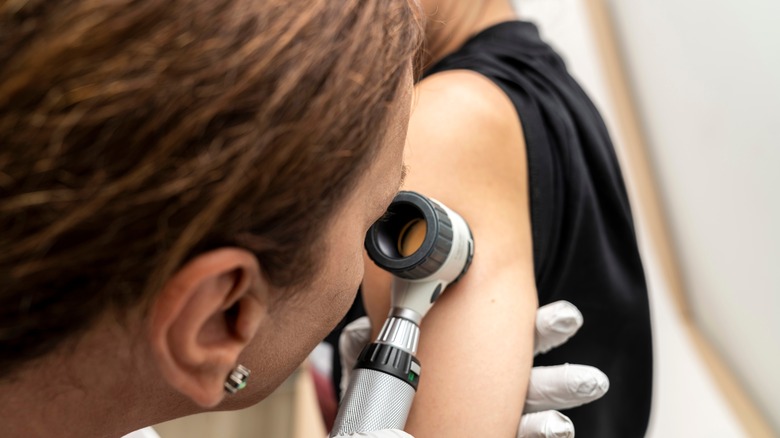Skin Tag Vs. Mole: The Real Difference Between The Blemishes
The human skin is a pretty impressive organ when you stop and think of all the things it can do. It can grow, stretch, change color in the sun, provide waterproof protection, control your body temperature, and heal if it's injured. You can pierce it, tattoo it, exfoliate it, moisturize it, darken it, and bleach it.
But not everything about the skin is positive. As you age, it can wrinkle and lose its firmness. Plus, not everyone is blessed with a perfect epidermis naturally. Some people have skin that's prone to acne, oiliness, or post-inflammatory hyperpigmentation. Other blemishes, including pimples, skin tags, and moles are another common concern.
Skin tags and moles share many similarities, but they also have some distinct differences in their appearance, texture, associated risks, and other areas. Perhaps you're more familiar with one than the other, either from personal experience or that of a loved one. So what are the differences between moles and skin tags?
The characteristics of a skin tag
A skin tag, scientifically known as an acrochordon, is a tiny protruding mass that develops on the surface of the skin, Cleveland Clinic explains. These tags are usually soft, wrinkled, and benign, and they match the natural skin color, but sometimes they can be several shades darker.
They can vary in size, ranging from 1 to 5 mm — about the size of a Nerds candy — to approximately half an inch, or the size of an M&M candy. Some can be even larger. Skin tags can appear on any part of the body, but they most frequently develop in body fold regions like the armpits, groin, and under the breasts.
Even if you've never seen someone with a skin tag — after all, they're easy to hide — this blemish is actually quite common; a 2022 StatPearls article published in the National Library of Medicine claims about 50 to 60% of adults "will develop at least one skin tag in their lifetime."
How to identify a mole
Like a skin tag, a mole — scientifically known as nevi — is a common, small blemish that grows on the skin (via Mayo Clinic). You've seen them on many well-known celebrities, including Eva Mendes, Cindy Crawford, Robert De Niro, Mariah Carey, Rachel McAdams, Enrique Iglesias (once upon a time), and the iconic Marilyn Monroe.
Moles are even more common than skin tags. It's likely that you either have one yourself or know someone who does. The National Cancer Institute states that about 332 million Americans have at least one mole somewhere on their body. These blemishes can vary in size, and it's common to have dozens of them on various parts of the body, like freckles.
Unlike skin tags, which often match the skin's natural hue, moles are usually darker than the natural skin color. They're typically a shade of dark brown, but they can also be black, red, or pink. In terms of texture, they can have the same wrinkled appearance of skin tags.
However, one key difference in the appearance between the two is that moles can be flat and smooth; skin tags are always protrusive. Moles can also grow hair through them, which is not the case with skin tags. In fact, Healthline claims hair can grow thicker and darker on a mole than on the adjacent skin.
What causes skin tags and moles?
If you have a tiny skin tag or mole, it's likely that you don't recall how long you've had it. That may be because you were born with it. Both moles and skin tags can be congenital, but it's possible to develop them later in life.
Moles develop as the result of skin cells growing in clusters that produce melanin, which can happen before or after birth, but the cause of this growth isn't fully understood. According to the Vascular Birthmark Center, experts suspect that age, sun exposure, prescription drugs, and genetics are some of the triggers of post-birth mole development.
Board-certified dermatologist Joshua Zeichner, M.D., spoke with Health about the development of moles after birth. "People usually start developing moles around the age of three or four, and it is considered normal to continue to get new moles until the age of 30," he said.
Skin tags develop when extra skin cells grow on the epidermis and dermis, which are the outermost layers of skin. This excess growth occurs as a result of skin-to-skin friction, which is why they commonly develop in body fold regions, as Cleveland Clinic explains. However, Orlando ENT claims that congenital skin tags, which commonly occur on the opening of the ear, may be the result of inner ear, facial bone, or kidney issues.
Are skin tags or moles dangerous?
The answer to this question is another differentiating factor between skin tags and moles. According to Healthline, skin tags are always benign. They are not cancerous when they develop, nor can they ever become cancerous. However, they can still be problematic for some people if they cause irritation to the adjacent skin. They can also get stuck in clothing or jewelry, which can cause them to bleed.
Moles, on the other hand, can be cancerous, which is a common reason that many people have them removed, but Johns Hopkins Medicine confirms that most of them are benign. Only a dermatologist can determine if a mole is cancerous, so it's best to have a skin cancer screening with a doctor annually. However, you should examine your moles at home much more frequently. Schedule a visit with your dermatologist if the mole has changed color or if it itches, becomes scaly, or bleeds.
How can skin tags and moles be removed?
Both skin tags and moles can be removed either surgically or via other means, but with some methods, you need patience. A skin tag can be removed with cryosurgery, which essentially involves freezing it until it falls off, but there are also at-home remedies that can be just as effective, according to Healthline.
At-home remedies include applying crushed garlic on the skin tag before bedtime and placing a bandage over it as you sleep. Applying tea tree oil instead of garlic can also work. Apply every night until the tag disappears. At-home freezing kits are another option.
Although some moles are tiny and barely visible, others are much larger and protrude from the skin, prompting some people to want to remove them. Like skin tags, moles can be removed with cryosurgery. They can also be shaved or burned off. In terms of at-home remedies, there are claims that certain oils and other liquids can remove a mole, but since some of these methods can be dangerous, doctors typically don't recommend them (via Healthline).
It's also important to note that skin tags and moles can disappear on their own, without any form of treatment. Just as moles can appear with age, they can fade or completely disappear with age as well. The American Skin Association claims the average lifespan of a mole is about 50 years. Skin tags can also fall off on their own over time, according to MedicalNewsToday.





